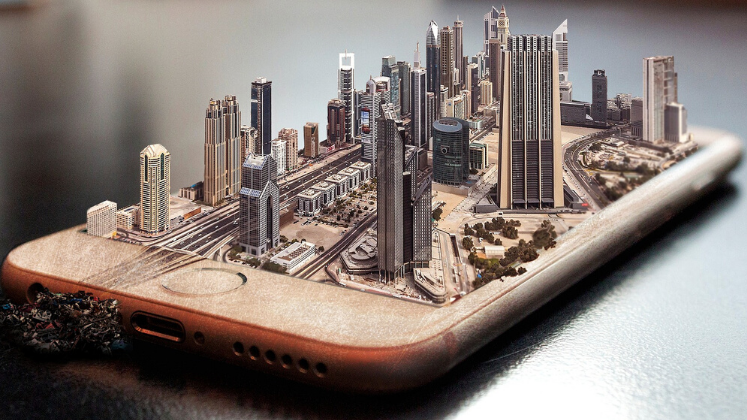In How to Run a City like Amazon and Other Fables – available to download here – editors Mark Graham et al offer 38 stories written by academics that utilise speculative fiction to explore how cities might look, feel and function, and the effects on society, economics and politics, if different business models and technologies were applied to the running of cities. The contributors conjure evocative visions of these imagined cities, allowing readers to drop into complex futures that seemingly involve more struggles than improvements, writes Lorenzo De Vidovich.
How to Run a City like Amazon and Other Fables. Mark Graham, Rob Kitchin, Shannon Mattern and Joe Shaw (eds). Meatspace Press. 2019.
 In the science-fiction romantic film Her, the director Spike Jonze displays a near future where humanity is permeated by artificially intelligent virtual assistants, so much so that Theodore, the protagonist, develops a relationship with Samantha, his self-named computer operating system. The film visualises a world where people share their intimate lives with their personal AI, communicating with them through an earphone. But what if the intelligence of such AI systems turns out to be almost unlimited?
In the science-fiction romantic film Her, the director Spike Jonze displays a near future where humanity is permeated by artificially intelligent virtual assistants, so much so that Theodore, the protagonist, develops a relationship with Samantha, his self-named computer operating system. The film visualises a world where people share their intimate lives with their personal AI, communicating with them through an earphone. But what if the intelligence of such AI systems turns out to be almost unlimited?
AI is a topic of increasing relevance. The research cluster ‘Nesta’ addresses the ways in which is possible to maximise AI in public decision-making, while the British government has just released a guide to using AI in the public sector. The huge amount of data produced to fuel digital and technological innovations encourages the improvement of many AI systems nudging our individual choices. In this respect, Stephen Goldsmith and Neil Kleiman state that cities would be more efficient, productive and governable if they become data-driven and act like Amazon: that is, like a company able to produce ‘a great experience for the customers’ via operating systems. This viewpoint is the starting point of How to Run a City like Amazon and Other Fables, an immersive and original book – edited by Mark Graham, Rob Kitchin, Shannon Mattern and Joe Shaw and available to download here – which excavates the dystopic urban future that can be increasingly imagined, even beyond science fiction.
Introduced by a discussion about contemporary cities in a time of urban neoliberalism through the prologue, ‘Amazon’, and grounded in academic studies and debates, the book is composed of 38 stories written by academics, mostly in the form of speculative fiction. Each chapter explores ‘how a city might look, feel and function, and the effects on society, economy and politics if different business models, practices and technologies are applied to the running of cities’ (11). The book is a thought-provoking read that imagines the possible negative externalities hidden in the data-driven application of consolidated business models to city governance. In this respect, the book unfolds the risks of transforming common goods into for-profit market items, with a visible criticality levelled at the application of ‘a range of disruptive innovations to civic administration and infrastructure that ideally are stable, reliable and risk adverse’ (12).
Nonetheless, the book does not represent a mere reaction to data-led cities, nor is it a collection of dystopias aimed at warning readers about digital and AI development. The diverse fables search for answers to an ostensibly simple yet complex question: do we really envision cities run as or even ‘managed’ by businesses? Do the next generations actually want to reside in highly innovative and innovated cities? The stories imagine such cities of the future. Each chapter uses extrapolation and speculation to explore possible worlds if cities were managed, for instance, by the big names of digital technology (such as Google, Apple and Tesla), by social media and web giants (such as Instagram, Twitter, Spotify and even Pornhub), or if they were fully data-dependent (with reference to Cambridge Analytica, Acxiom and Palantir), gamified (Sony PlayStation) or based upon consolidated models such as Ikea or Starbucks. By selecting a contemporary big name, the authors encourage reflection through fictional thought experiments and semi-academic arguments, without any evident personal statements affecting the narratives.

Image Credit: (Pixabay CCO)
Amongst the multitude of contributions, which follow each other in alphabetical order according to the company’s name from ‘Acxiom’ onwards, three pieces stand out as embodying the substance of the book (see the whole table of contents here). In the fable ‘Apple – Welcome to Jobstown’, Sophia Maalsen and Kurt Iveson invent a future where Apple Inc. runs its own ‘smart city’. In 2029, life in Jobstown is the outcome of Apple’s investments in ‘smart urbanism’ through leveraging the market dominance of digital platforms and electronics. Everything seems to be running well, as there is no shortage of jobs, housing, infrastructure and civic engagement. Yet, ‘Jobstown does not tolerate a laissez-faire attitude to technology’ (199). The inhabitants decided to live there motivated by a faith in the corporation’s vision, but this entails a complete sharing of personal data with it. In its extraordinary nature, Jobstown has the shape of an urban utopia.
In ‘Easyjet – Easycity’, Manuel Aalbers offers an immersive and thoughtful contribution by merging satire and a thought experiment in a playful dialogue between a seller and a couple looking to get a place in EasyCity, a town run on the model of low-cost airlines, where many additional travel costs add up to the basic service. In EasyCity, the inviting Standard EasyFlat costs only £99 per week, but it consists of a bed-studio with a small kitchenette. Flexi EasyFlat is a more suitable solution for a couple, but it costs more, with additional overlapping expenses, covering items from a window to transport.
Although using science fiction as a form, the thread of the book is academic reflection, as demonstrated by the chapter ‘Ikea – Flat-Pack Smart Urbanism’, written by Martin Dodge, which conjectures how a city might look if run and experienced according to Ikea’s model of product self-assembly. Dodge wonders whether such an archetype of consumer capitalism, labelled as ‘prosumption’ (see George Ritzer and Nathan Jurgenson, 2010), is a valuable analytical pathway to think about future urbanism.
More extreme scenarios are envisaged in other dystopias. This is the case of the 2041 ‘Global Linguistic Crisis’ pictured by Pip Thornton, taking inspiration from Google AdWords, and the chapters based upon big data businesses, such as the data-driven life envisioned in ‘Acxiom – You’re Entitled to what the Data says you Deserve’, where service provision to citizens is determined by a data-broker according to specific individual features. Or again, the story inspired by Shotspotter – a gunfire locator’s company – illustrating the pursuit of happiness by a couple in a militarised surveillance regime, similar to the one portrayed in the music video for The Suburbs by Arcade Fire, another of Jonze’s directorial projects.
The immediate message of How to Run a City like Amazon is that there is good reason to be cautious in applying for-profit business and overwhelming innovations in public affairs, as a city based on Amazon rationale – that is, operating like a planetary business – may hide many negative externalities. The complexity of governing a city and the affirmation of business models, in particular those leveraging technology, are not necessarily two fully congruent systems. The benefits of the latter are aimed at ameliorating, rather than determining, the efficiency of the former. Each speculative fiction is the result of an in-depth study that deploys heterogenous imaginations to conjure cities run like Amazon and other entities, and the sensation of dropping into complex futures that involve more struggles than improvements is perceptible while reading. The book has a powerful particularity, enabling polysemic and accessible usage by students, scholars and general readers.
Note: This review gives the views of the author, and not the position of the LSE Review of Books blog, or of the London School of Economics.







